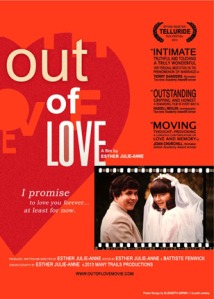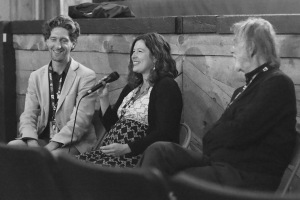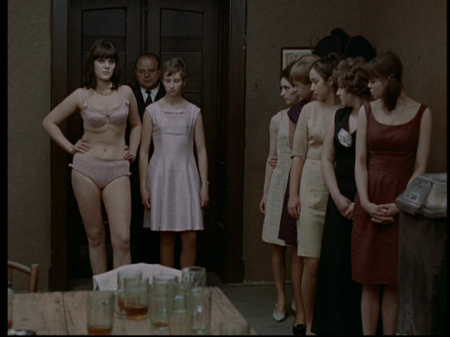I descend into Telluride each day in what they call a gondola, though it comes without a man singing Italian opera while wielding a punt — it’s a cable car that dangles you above the deer and bears and trees and afford a spectacular, gently lurching view, the perfect combination of beauty and terror, a bit like being attacked by Halle Berry with a hammer.
It’s impossible to choose from the wealth of stuff on show so I’ve been trying to repay the nice filmmakers who have attended NATAN by seeing their films. We met Battiste Fenwick and Esther Julie-Anne and hit it off and so I dragged myself to their films at 9.20 am Friday — if not for insomnia I’d never have managed it. And I was SO glad I did.
In a day that included Pierre Rissient screening MUSCLE BEACH and an episode of The Alfred Hitchcock Hour, Don DeLillo reading from Underworld as accompaniment to the Zapruder Film, stories read aloud/performed by Jason Reitman, Buck Henry, Gregory Nava, Teller, Tamara Jenkins, Joyce Maynard, Salman Rushdie and Michael Fitzgerald, Battiste and Esther’s films, documentaries produced at UCLA, were still probably the highlight.
They’re a husband-and-wife team, each having directed one movie and edited the other. And their wedding forms a part of one of the movies, and they now have their first kid very much on the way. The films were submitted separately to Telluride but the smart programmers realized that the two movies make a perfect double feature, being wildly different yet underneath, if not similar, certainly mutually complimentary in all kinds of ways.
Q&A chaired by Godfrey Reggio, left. Photo by Richard Parkin.
The screening was sparsely attended: it must have been crushing to see those empty seats — but everyone who was there had an unforgettable experience. Unforgettable. And we were privileged. These films deserve a HUGE audience.
Battiste has made UNA CHANZA MAS (ONE MORE CHANCE) about Pedro, a former LA gang member attempting to build a new life, and Esther has made OUT OF LOVE, a film about her much-married father, his “harem” of ex-wives, and his relationship with his kids, in an attempt to discover whether love can last. Two very different films which resonate beautifully with each other. I rarely cry at movies (well, fairly rarely), and certainly not more than once per movie, but I was a mess here, and fully expected to be bursting into tears all through the rest of the day. Fortunately the other entertainers listed above kept me distracted, but I may go weep into my pillow now. It’s 01:36 am and I’m pretty tired. I want to write more about these movies soon and I urge everyone to see them.
Happy endings department — word spread — Telluride is a word-of-mouth film festival — Godfrey Reggio likens it to an ocean liner where you stroll around and meet the same people again and again. For their second screening, Esther and Battiste had a huge full house, and again an amazingly enthusiastic response. Another of the magic Telluride stories everyone seems to have, and well-deserved. These are filmmakers to watch, and they are now well and truly LAUNCHED.









